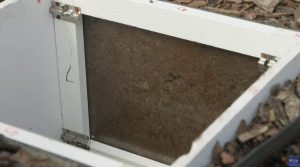UF/IFAS researchers are continuously searching for ways to support the Florida blueberry industry. One example of research has been by UF/IFAS Horticultural Sciences researcher Dr. Gerardo Nunez and Lauren Goldsby, a graduate student in the Small Fruit Horticulture Lab. Their research project was to improve the nitrogen-use efficiency in blueberry farms in the Southeast.
Nitrogen is a chemical element, and it is a component of all the proteins in plants, in humans, and in animals. Plants take up nitrogen from their fertilizer, so nitrogen is very important for plant nutrition. There are two forms of nitrogen used in fertilizers: Ammoniacal nitrogen and nitrate nitrogen. Blueberries prefer ammoniacal nitrogen, but ammoniacal nitrogen can be converted to nitrates in the soil. Dr. Nunez relayed that
Nitrates are particularly problematic because they don’t stick around in the soil. So when we fertilize with excess nitrogen fertilizer, those nitrates can leach deeper than the plant and end up in water sources. When nitrogen leaves the farm, it’s going to lead to degradation of aquatic ecosystems. In addition, nitrogen fertilizer is expensive, so leached nitrogen leads to higher expenses for growers.”
Nunez continued, “Roots are the plant organ that specialize in nutrient uptake, so learning more about roots allows us to make better fertilization decisions. We started investigating root flushes, which would be a period of root growth because we didn’t have any information about that for Southern Highbush Blueberries. Root flushes are periods where there’s more abundant roots. And in the time when there’s more roots, there’s more nutrient uptake. Therefore, we think that the root flushes represent an opportunity for efficient fertilization in Florida and beyond.”
Goldsby explained the research process: “A root flush is essentially a growth spurt for the plant. We observed root flushes by using root observation boxes, which we built for this experiment in order to see the roots under the surface. These boxes have two acrylic windows which face either side of the plant that they’re placed in between. These windows allow us to observe what the roots are doing over time.
By taking photos of these windows at different periods throughout the experiment, we were able to analyze them using image trace software in order to create quantitative data that we can use to compare the root lengths.”
From this research, they were able to determine there were root flush periods in the late Spring and in the Fall. And once they knew when these root flashes were occurring, they observed nitrogen uptake before and during this root flush period.
By using isotopes, a chemical tracer, they were able to measure nitrogen uptake during and after the root flush period. After two years of research, Nunez and Goldsby found that blueberries, like other plants, are going to have root flushes. And that during these root flushes, nutrient uptake is greater than when the plants are not in the root flush. By using this information, the researchers will be able to inform decisions on the timing of fertilizer applications in Southern Highbush Blueberry production.
Funding for this project was provided by the USDA Southern Sustainable Agriculture Research and Education (SARE) and the Florida Department of Agriculture and Consumer Services.
Video production: Kat Antunes
 0
0

